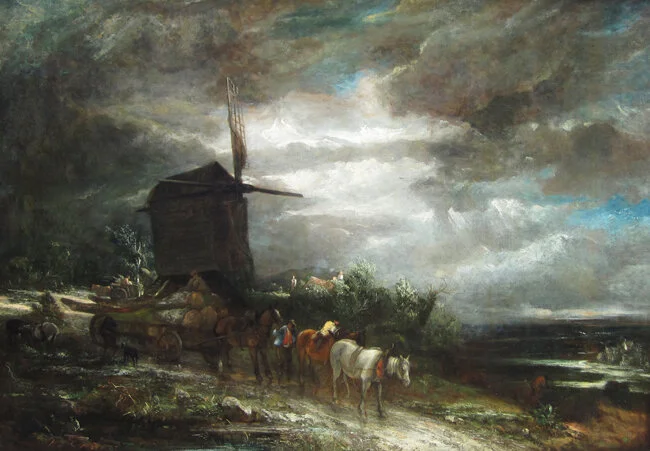JOHN CROME PAINTINGS FOR SALE & BIOGRAPHY
JOHN CROME
British, 1768–1821
BIOGRAPHY
“An English landscape painter, who was born, worked, and died in Norwich. John Crome was of humble origin and was first apprenticed to a coach and sign painter. He was befriended by Thomas Harvey of Catton, an amateur painter and collector, in whose collection he studied works by Thomas Gainsborough (1727–1788) and the Dutch masters, Meindert Hobbema (1638–1709) in particular. He was also influenced by Richard Wilson (1714–1782) and must have seen landscapes by Rembrandt (1606?–1669). He established himself locally as a landscape painter, was a founder member of the Norwich Society of Artists in 1893, and exhibited intermittently in London at the Royal Academy and the British Institution. He earned a part of his livelihood as a drawing master. His only journey abroad was to Paris in 1814 to see the exhibition of the pictures which had been seized by Napoleon.
Crome painted a number of small pictures of woodland clearings and mills or houses by the riverside, which are Dutch in conception though not in execution. With John Sell Cotman (1782–1842), he was the major artist of the Norwich School and his reputation stands high in the history of English landscape painting. The most important of his larger works are Slate Quarries (London, Tate), Moonrise on the Marshes of the Yare (London, NG), Mousehold Heath (London, Tate), and The Poringland Oak (London, NG). Of these the first two are thought to belong to the decade 1800–10, the last two to 1810–20. They are marked by a broad handling of the paint, a bold realization of space, and keen appreciation of local characteristics.
John Crome, together with Wilson, represents the transition from the 18th–century picturesque tradition to the romantic conception of landscape. He rarely painted in the open air but composed his oils from watercolors and drawings made on the spot and from prints and etchings, of which he made a collection. His larger compositions lack the architectural quality of classical construction and have been accused of woolliness in realization; but they are often saved by a unity of mood which anticipates the Romantics (Yarmouth Jetty, Norwich, Castle Mus.). He himself said in a letter to his disciple James Stark: ‘do not distress us with accidental trifles in nature but keep the masses large and in good and beautiful lines, and give the sky, which plays so important a part in all landscape, so supreme a one in our low level lines of distance, the prominence it deserves, and in the coming years the posterity you paint for shall admire your work.’
He is sometimes referred to as ‘Old Crome’ to distinguish him from this son, who painted in his manner but with inferior talent” (Osborne, Harold, The Oxford Companion to Western Art, 2003).
Museum Collections:
Art Institute of Chicago, Chicago, IL
Ashmolean Museum, Oxford
Courtauld Institute of Art, London
Fitzwilliam Museum, Cambridge
Harvard Art Museums, Cambridge, MA
Huntington Library, San Marino, CA
Manchester City Art Gallery, Manchester
Metropolitan Museum of Art, New York, NY
Musée du Louvre, Paris
Museum of Fine Arts, Boston, MA
National Gallery of Art, Washington, D.C.
National Gallery of Victoria, Melbourne
Philadelphia Museum of Art, Philadelphia, PA
Tate Gallery, London
Victoria and Albert Museum, London
Mark Murray Fine Paintings is a New York gallery specializing in buying and selling 19th century and early 20th century artwork.
Please contact us if you are interested in selling your John Crome paintings or other artwork from the 19th century and early 20th century.
JOHN CROME
Paintings for sale
John Crome Paintings Previously Sold
JOHN CROME
A View near Woodbridge, Suffolk
Oil on canvas
26 x 31 inches (66.1 x 78.7 cm)
SOLD




